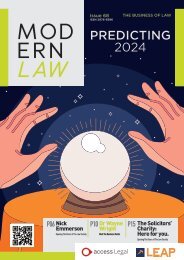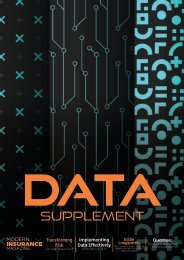Modern Insurance Magazine Issue 65
Create successful ePaper yourself
Turn your PDF publications into a flip-book with our unique Google optimized e-Paper software.
Consumer Duty<br />
Defines the Role<br />
EDITORIAL BOARD<br />
Contrary to popular thought, e2e is not a salvage<br />
company.<br />
Of course, our supporting network members are some of the best<br />
salvage agents in the country. Bringing that array of talent and<br />
capability together, working on behalf of our insurer and claims<br />
manager clients, is a real privilege. Providing vehicle auction, a<br />
reclaimed parts portal, and national initiatives such as our Sustain 360<br />
ESG programme gives us and our supplier members the opportunity<br />
to provide our clients and customers with real added value.<br />
However, these platforms are merely a ‘means to an end’. It’s clear<br />
to us that we form an integral part of the Consumer Duty chain, and<br />
our fundamental role is to help our clients and consumers alike when<br />
it comes to maximising returns from an otherwise wasted asset, and<br />
minimising the massive inconvenience that a total loss causes for<br />
everyone.<br />
In that sense, it is the Consumer Duty that defines our real purpose.<br />
It’s often easy to get lost in the technicalities of managing the<br />
consequences of a total loss decision and, of course, we can never<br />
forget that there are indeed a vast number of issues that need to be<br />
managed - from the safe and environmentally compliant disposal<br />
of vehicles, through to the best practices of our auction site and<br />
automated matching of reclaimed parts supply with demand.<br />
Customers Drive our Behaviours<br />
But we must always see the end-user customer as being our ultimate<br />
point of reference. Insurers, their claims managers (if they outsource)<br />
and their suppliers are always working on behalf of policyholders. In<br />
our case, every last pound of realised sales revenue from auctions<br />
goes towards keeping premiums lower than they otherwise would<br />
be. Maximising the use of reclaimed parts helps to keep repair costs<br />
down, which, in turn, reduces upwards pressure on costs. Countering<br />
fraudulent claims not only helps to catch criminals but also, once<br />
again, provides protection for the end customer.<br />
Thought of this way, the Consumer Duty is not a set of obligations,<br />
regulations, or policies. Instead, it is the very definition of who we are<br />
as a business – and it should define every business in the financial<br />
services sector. We only exist to service the needs of our customers,<br />
and if we get this right, then sustainable profits will naturally flow.<br />
Of course, there are some who will put the pursuit of profit ahead of<br />
almost every other consideration. There are those who will seek to<br />
bend the rules. There are those who resent the Consumer Duty.<br />
Here at e2e, we don’t work with those people.<br />
Jim Loughran,<br />
CEO, e2e Total Loss Vehicle Management<br />
Reacting to 2024’s<br />
Key Trends<br />
This year, we’re seeing a heightened focus on<br />
controlling claims costs, improving operational<br />
efficiency, and tackling fraud. This is where data<br />
enrichment - for both the individual and the vehicle<br />
or property, through increasingly granular realtime<br />
data - has the power to reduce loss costs<br />
for insurance providers, and lower premiums as a<br />
result.<br />
In motor insurance, knowing to what extent the safety technology on<br />
a car cuts accident risk is crucial, and it is becoming even more critical<br />
as car technology evolves. It’s why we have already taken huge steps<br />
to ensure the insurance sector understands this technology in order to<br />
price effectively through our award-winning advanced driver assistance<br />
system (ADAS) data enrichment solution – LexisNexis® Vehicle Build.<br />
Furthermore, our strategic alliance with Thatcham Research means<br />
insurance providers will have streamlined and automated access to<br />
Thatcham Vehicle Risk Data (VRD) 1 for the first time, something which<br />
is integral to insurance pricing and consistency over the matching<br />
of vehicles to Thatcham VRD. The more intelligence that insurance<br />
providers can access on the specific vehicles they are insuring, the<br />
more accurate the premium will be. They will also be more likely to<br />
deliver a swift claims experience.<br />
From a fraud perspective, email address intelligence through<br />
LexisNexis® Emailage® Rapid is being used to flag the risk of fraud for<br />
insurance providers in a seamless and frictionless way at the point<br />
of quote. Highly granular cross-market claims data coming from<br />
LexisNexis® Precision Claims later this Spring will add further detail to<br />
the picture, helping insurance providers identify fraudulent behaviours<br />
at quote through to claim.<br />
Fraud prevention also extends to quote manipulation. Responding to<br />
this challenge, it is now possible to uncover changes between quotes in<br />
key fields prone to manipulation. This helps protect insurance providers<br />
from inaccurate pricing and potential fraud, while consumers avoid<br />
their policies being rendered null and void if deliberate misstatements<br />
are uncovered at claim.<br />
Finally, in a recent report from data consultancy firm Sagacity titled<br />
‘Missing Billions: The Impact of Revenue Leakage on UK Business’, 95%<br />
of the insurance providers surveyed said revenue loss comes from the<br />
wrong policy for the customer or charging the wrong amount. This<br />
is likely to be down to the vast volumes of customer data insurance<br />
providers typically manage, increasing the chances of the same<br />
individual appearing multiple times across different databases within<br />
an insurance group without the dots being joined up. This can lead<br />
to inaccurate pricing at renewal, the risk of fraud, wasted marketing<br />
budgets and increased operational costs, as well as lost cross-sell and<br />
upsell opportunities.<br />
<strong>Insurance</strong> providers can gain a comprehensive real-time view of the<br />
customer at each stage of the journey - but most importantly, at the<br />
point of quote - using linking and matching technology to create a<br />
single customer view. This can help guarantee that the right product is<br />
being offered for the risk presented, and at the right price.<br />
Tom Lawrie-Fussey,<br />
senior director of product management, UK and Ireland,<br />
LexisNexis Risk Solutions, <strong>Insurance</strong><br />
1<br />
Thatcham Research Vehicle Risk Data is a live and extensive, industry-standard dataset that<br />
contains key information about insurable cars, LCVs and motorcycles. Thatcham Research<br />
is solely responsible for maintaining this dataset with each vehicle containing more than 100<br />
individual data points.<br />
Using data exclusively supplied by vehicle manufacturers and checked by Thatcham<br />
Research’s expert data team, each vehicle is assigned a unique eight-digit ABI identification<br />
code. This translates into a standardised description of the vehicle that is used by the entire<br />
insurance industry.<br />
Directly sourced data is also used to generate a Group Rating score for every vehicle. Ranging<br />
between 1 and 50 for cars and 21 to 50 for LCVs, scores indicate the level of insurance risk<br />
associated with the vehicle.<br />
MODERN INSURANCE | 19
















